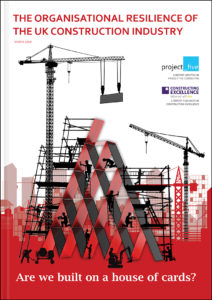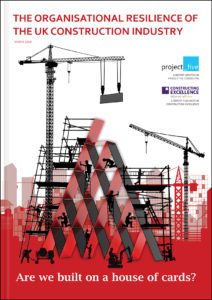IN WAKE OF CARILLION COLLAPSE, CONSTRUCTING EXCELLENCE PUBLISHED REPORT REVEALS ALMOST HALF (43%) OF CONSTRUCTION FIRMS PRIORITISE IMMEDIATE FINANCIAL GOALS OVER ORGANISATIONAL RESILIENCE
The organisational resilience of the UK construction industry: Are we built on a house of cards? report reveals the key obstacles to embrace organisational resilience, identified among the 100 senior business managers and executives within UK Construction Organisations surveyed[1]:
- Immediate financial goals are more urgent – 43%
- Inadequate budget – 27%
- Lack of skills or knowledge related to ensuring resilience/business continuity – 27%
- Insufficient senior management focus on resilience – 19%
- Opaque operations or practices, making the effects of organisational actions towards increased resilience unclear – 14%
- 29% stated they didn’t see any obstacles.
The report’s purpose – to provide an overview of how resilient the industry is in relation to a range of internal and external factors – explores the role of organisational resilience in enabling construction companies to adapt to changing conditions. It addresses the evidence of failure, posits why they fail, considers the issues, areas of risk, and proposes how to build resilience and the benefits therein of doing so for the individual companies and the sector as a whole.
Don Ward, CEO of the report’s publishers, Constructing Excellence, says: “The collapse of Carillion has kick started a wide-ranging debate about the causes, including how underlying business models need to change. The report asks whether the industry is built on a house of cards, which it surely is, and the call to action for companies to assess their ability to respond to incremental changes and sudden external disruptions and to act on these findings is therefore extremely timely.”
The report, written by Project Five Consulting, has identified the construction industry as a key enabling sector for the wider UK economy. A resilient sector should be good for UK plc. However, it has a higher rate of failure than the average across all industry sectors. This fragility is underpinned by structural issues that characterise the weaknesses in the industry. These are borne out by the recent collapse into liquidation of the country’s second largest construction company, Carillion.
There are also economic, political and market uncertainties facing the sector alongside the disruptive forces of technology and increased regulation. Based on the findings, the report has identified a range of priority actions to help the industry understand and embrace approaches to organisational resilience. These include strategic actions to address the structural issues and weaknesses identified: low levels of profitability; a fragmented supply chain; adversarial client/contractor/sub-contractor relationships; skills weaknesses; low digital maturity; low productivity.
The construction industry’s lack of resilience has been evidenced. The most recent figures from the Insolvency Service[2] (which has taken over the collection of data from the Office for National Statistics) on the total new company insolvencies in England and Wales for the year ending Q3 2016, show that there were more insolvencies in construction than in any other sector. The total was nearly 2,500. When the data are aggregated by the ONS, they show that construction accounts for 16.5% of all insolvencies, but only 7% of economic output (by GDP) and 7.5% of total company numbers.
The construction industry’s failings matter because it is one of the largest sectors – with a turnover of £370 billion, contributing £138 billion in value added to the UK economy and employing 3.1 million people (9% of the total UK workforce). It is also an enabling sector. The industry provides the buildings and infrastructure upon which the rest of the economy and the public sector relies. A resilient industry, made up of resilient organisations, which is responsive and adaptable to the country’s evolving needs is vital to support the growth of the economy and the delivery of public services.
Alarmingly, the sector’s future looks even less resilient. Accountancy firm Moore Stephens, in a 2017 study which showed that 26% of construction companies currently exhibit warning signs that indicate they are at risk of failure. The analysis from Moore Stephens’ ‘Moore Data’ service of construction companies (registered as limited companies with Companies House – Year end 13 June 2017), identified key factors for this as follows:
- Construction sector is under pressure due to tightening margins as the fall in Sterling since the EU referendum has pushed up import costs, with smaller contractors’ profitability among the hardest hit;
- Smaller companies can also find it harder to access bank lending for projects, putting cash flow under strain;
- Construction companies could face further problems in the future if access to skilled labour becomes more limited following Brexit, pushing up wage bills.
These figures are further supported by the Begbies Traynor Red Flag Alert business survey, which showed that the number of construction companies in ‘financial distress’ grew 31 per cent in the final quarter of 2017 compared with 12 months earlier. Meanwhile credit information provider Creditsafe reported that the volume of ‘bad debt’ (debts which cannot be recovered) owed to construction companies rose to £12.7m in Q4 2017 – a £3.6m increase on the previous quarter. It also found that 539 industry firms collapsed in the final three months of the year an increase on the previous quarter.
The reasons for the sector’s lack of resilience have been documented by several studies. Research by Jagafa and Wood (2012), from the University of Salford, supported by previous research by Jonathan (2002) and Langdon (2012), reported that cash flow shortages, falling profits, failure to pay suppliers, delayed and /or reduced valuation certificates, progress of works slowing, insufficient resources deployed on the project, falling asset values, excessive borrowing, or even boardroom tensions are signs of company financial difficulty but are often overlooked by management.
The organisational resilience of the UK construction industry: Are we built on a house of cards? survey provided a snapshot of some of the key risks against which organisations need to build resilience. Some of the common issues identified in wider research were also reflected in the responses received, such as macroeconomic uncertainty. However, the respondents also identified issues including disruptive competitors, reputational risks and threats to information security.
- Disruptive competitors in the market – 42%
- Macroeconomic uncertainty/events – 32%
- Political instability/civil unrest – 28%
- Reputational risk (e.g. on-site accidents, non-compliance) – 27%
- Threats to information security – 23%
- Corruption/bribery – 19%
- Environmental changes/natural disasters – 17%
- Increased incidence of terrorist attacks and other crime – 11%
In the face of these identified macroeconomic, political and industry-specific challenges, the case grows stronger for the sector to address its approach to organisational resilience to de-risk itself. In developing its framework for organisational resilience, BSI, who supported the report, has identified three core functional domains:
- Operational resilience – focused on internal continuous improvement activities with a customer focus in mind.
- Supply chain resilience – to quantify and minimise supply chain risks across all business operations.
- Information resilience – managing information throughout its lifecycle securely and effectively.
The benefits of developing an organisational resilience framework, as expressed by those surveyed, include:
- Long term viability – 56%
- Protecting reputation – 42%
- Improved financial performance – 32%
- Improved competitiveness by minimising disruptions – 29%
- Operational efficiencies – 29%
The report’s priorities and recommendations include:
- Further research into the resilience of the industry and the characteristics which appear to make it more vulnerable to shocks and the reasons why the failure rate is higher than other industries.
- Learning the lessons that will emerge from the collapse of Carillion and the impacts on the industry as a whole.
- Develop a more robust evidence base of the benefits to the industry of embracing approaches to organisational resilience to address concerns over the required investment.
- Develop industry-specific approaches which enable construction companies to identify and understand the external influences that threaten the sector as well as those that are driving positive change.
- Develop approaches to support leaders in construction to up-skill them and enable them to provide the strategic leadership required to drive organisational resilience, including the abilities to identify the sudden shocks and incremental changes.
- Develop industry-specific approaches to enable construction businesses to build resilience into their business plans and their business processes in line with the BSI’s model and BS 65000.
- Identify the key knowledge gaps and the skills needed in relation to organisational resilience to develop a roadmap to address these shortfalls.
- Leadership from government to continue to place the strategic priorities for industry improvement in the context of the resilience of the industry, including skills and training, digitisation, procurement approaches, pipeline visibility and approaches to collaborative working led by clients.
Tim Whitehill, Managing Director of the report’s authors, Project Five Consulting, concludes: “A resilient industry is good for clients, for the workforce, for communities and for the economy. Organisational resilience is a real opportunity to enable the industry to weather the storm, grasp opportunities as they arise and put itself onto a firm footing for the future.”
The report can be downloaded at: Project Five’s Website
[1] The report is based on a combination of survey work carried out with a sample of organisations across the UK construction industry, and desk-based research to review the wider evidence base relating to resilience in the sector. The research and the analysis of the data we collected was carried out during the second half of 2017 – pre-Carillion collapse but all the more pertinent in its wake.
[2] Insolvency Statistics – October to December 2016 (Q4 2016) https://www.gov.uk/government/uploads/system/uploads/attachment_data/file/586287/Q4_2016_statistics_release_-_commentary.pdf




Comments are closed.